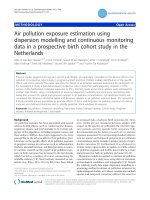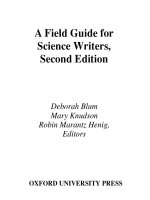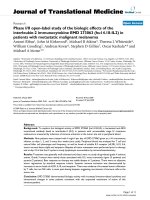A field and geochemical study of the boundary between the nanga parbat haramosh massif and the ladakh arc terrane, northern pakistan
Bạn đang xem bản rút gọn của tài liệu. Xem và tải ngay bản đầy đủ của tài liệu tại đây (3.64 MB, 146 trang )
An Abstract Of The Thesis Of
Philip L. Verplanck
Geology
for degree of
presented on
Master of Science
November 17, 1986
.
Title:
in
A Field
and Geochemical Study of the Boundary Between the Nanga Parbat-Haramosh
Massif and the Ladakh Arc Terrane, Northern Pakistan.
Redacted for Privacy
Abstract appro e
Lawrence Snee
The Nanga Parbat-Haramosh massif (NPHM) is a north-south trending
structural and topographic high, which interrupts the east-west trend
of the Himalaya in northern Pakistan. Previously, the massif was
thought to be bounded by the Main Mantle thrust (MMT), a north-dipping
thrust along which the Kohistan-Ladakh arc was thrust south over the
northern margin of the Indian continent. This study presents field and
geochemical data suggesting that the eastern boundary of the massif,
the Stak fault zone, is a young feature that displaces the suture zone.
The Stak fault zone marks the boundary between Precambrian
kyanite-sillimanite bearing biotite gneiss of continental affinity and
Cretaceous (?) arc lithologies of the western Ladakh terrane. The arc
complex consists of amphibolitic country rock that has been intruded by
gabbroic to tonalitic plutons. The protolith of the amphibolite is
immature oceanic island arc tholeiitic basalt. The mafic to intermediate plutons are dominantly calc-alkaline and could have formed in
either a mature island arc setting or a continental margin setting. The
Ladakh arc terrane exposes the upper section of an arc, below the
sedimentary and volcanic cover.
The Stak fault zone is a 3-5 km wide zone containing at least four
major high angle faults that separate blocks of various lithologies.
The only true mylonite zone occurs along the westernmost fault. A
faulted late stage dike is evidence for recent activity along the
easternmost fault. The units along the western side of the fault zone
are analogous to deep oceanic arc lithologies; tholeiitic amphibolite,
banded gneiss, and a section of a layered mafic complex. The units
along the eastern side of the fault zone are mineralogically and
chemically correlative to the mafic plutons exposed in the western
Ladakh terrane.
The geometry of the fault zone, the lack of suture zone lithologies, and the evidence for recent activity suggest that the Stak
fault zone does not represent the suturing event, when the KohistanLadakh arc was obducted onto the northern margin of India. Instead, the
fault zone is likely formed in response to the recent uplift of the
NPHM.
A Field and Geochemical Study of the
Boundary Between the Nanga Parbat-Haramosh Massif
and the Ladakh Arc Terrane, Northern Pakistan.
by
Philip L. Verplanck
A Thesis
submitted to
Oregon State University
in partial fulfillment of
the requirements for the
degree of
Master of Sceince
Completed November 17, 1986
Commencement June 1987
APPROVED:
Redacted for Privacy
Dr. Lawrence W. Snee, Assistant Professor of Geology in charge of major
Redacted for Privacy
G. Johnson
airman of the Department of Geology
Redacted for Privacy
Dean of Gradate Schoolci
Date thesis is presented November 17, 1986
Thesis presented by Philip L. Verplanck
ACKNOWLEDGEMENTS
I am indebted to an assortment of people who have made the
completion of this thesis possible and enjoyable. The list is headed by
Dr. Larry Snee who provided endless guidance, support, patience, and
humor. I appreciate and admire his efforts. Numerous discussions with
Drs. Roman Schmitt and Scott Hughes not only strengthened the thesis
but also showed me what it takes to be a researcher.
Drs. Ali Humzi Kazmi and Robert Lawrence, and Ian Madin introduced
me to the area and provided logistical, intellectual, and moral ,
support. Funding for the field work was provided by NFS grant # INT
81-18403. The field work could not have been completed without the aid
of personnel from Gemstone Corporation of Pakistan and Peshawar
University. Special thanks go to Ian, Riaz, Shafique, Shokot, Quadam,
Javed, Ajad, Karen, Larry, and Emily who shared in the joys as well as
the gourmet meals.
Reactor facilities and counting equipment was provided by an
unsponsored research grant from the 0.S.U. Radiation Center.
Technical assistance was provided by M.R. Conrady, T.V. Anderson,
W.T. Carpenter, and A.G. Johnson.
The assortment of personalities in the geology and marine geology
departments provided many special moments. The years spent with these
folks were full of fun and humor.
Most of all I what to thank my wife, Emily, and family for
their undaunting support. I admire the strength they showed in the past
year and a half.
Table of Contents
Introduction
Background
Regional Setting
Previous Work
Purpose and Procedure
Analytical Methods
Nanga Parbat Massif
Lithology Section
Shengus Gneiss
Baraluma Amphibolite
Pegmatites
Mafic Dikes
Geochemistry ands Its Implications
Major Element Geochemistry
Shengus Gneiss
Baraluma Amphibolite
Mafic Dikes
Trace Element Geochemistry
Shengus Gneiss
Baraluma Amphibolite
Mafic Dikes
Nanga Parbat Structure
Section Summary
Ladakh Terrane
Lithology Section
Talu Amphibolite
Twar Tonalite
Shuat Diorite Complex
Dasu Tonalite Porphyry
Felsic Dikes
Geochemistry
Major Element Geochemistry
Talu Amphibolite
Shuat Diorite Complex
Dasu Tonalite Porphyry
Felsic Dikes
Trace Element Geochemistry
Talu Amphibolite
Shuat Diorite Complex
Dasu Tonalite Porphyry
Felsic Dikes
Geochemical Synopsis
Ladakh-Kohistan Comparison
Conclusions and Implications
1
1
4
6
8
9
11
14
14
18
18
21
21
23
27
29
31
31
31
33
37
40
43
47
48
49
51
52
52
54
54
56
56
56
59
59
60
60
62
64
64
64
67
68
Stak Fault Zone
Discussion of Major Faults
Majupah Fault
Gainji Fault
Stak Chi Fault
Askore Fault
Other Faults
Structural Synopsis
Variation along Strike
Lithology Section
Introduction
Fragmented Layered Mafic Complex
Amphibolites
Banded Gneiss
Diorites
Felsic units
Continental Blocks
Geochemistry Section
Major Element Geochemistry
Layered Gabbro
Mafic Units
Western Mafic Units
Amphibolites
Banded Gneiss
Eastern Mafic Units
Felsic Units
Continental Blocks
Trace Element Geochemistry
Amphibolites
Banded Gneiss
Diorites
Felsic Units
Continental Blocks
Lithological and Geochemical Synopsis
Conclusions
72
78
78
81
83
83
84
86
87
89
89
89
91
93
94
94
97
99
99
99
99
102
102
105
105
106
106
109
109
111
114
Conclusions and Implications
125
References
132
114
117
120
122
List of Figures
Page
Figure
1.1
1.2
1.3
Location of Massif
Location of Study Area
Location of Other Studies
2.1
2.2
2.3
2.4
2.5
2.6
2.7
2.8
2.9
2.10
Generalized Geologic Map
Pressure and Temperature Conditions
Exsolution Texture in Shengus Gneiss
Exsolution Texture in Baraluma Amphibolite
Pegmatite Cavity
ACF Diagram
AFM Diagram
ACF Diagram of Gneisses
ACF Diagram of Mafic Units
Fe0* vs. Si02 and Fe0*/Mg0 vs. Fe0 for the
Basaltic Dikes and Ladakh Lithologies
REE Diagram of Finely Laminated Shengus Gneiss
REE Diagram of Equigranular Gneisses
REE Diagram of Iskere Gneiss
REE Diagram of Amphibolites
REE Diagram of Basaltic Dikes
Photograph of West Limb of Bulache Antiform
Photograph of East Limb of Bulache Antiform
2.11
2.12
2.13
2.14
2.15
2.16
2.17
3.1
3.2
3.3
3.4
3.5
4.1
4.2
4.3
4.4
4.5
4.6
4.7
4.8
4.9
4.10
4.11
4.12
4.13
4.14
4.15
4.16
4.17
4.18
Fe0* vs. Si02 and Fe0*/Mg0 vs. Fe0 for the
Basaltic Dikes and Ladakh Lithologies
ACF Diagram of Ladakh Units
REE Diagram of Ladakh Units
Range of Trace Elements in MORE vs. OIT
REE Diagram of Late Stage Granitic Dike
2
3
7
12
15
17
19
22
25
26
28
30
32
34
35
36
38
39
41
42
57
58
61
63
65
73
Photographs of Stak Fault Zone
74
Sketch of Units within Figure 4.1
75
Generalized Geologic Map
76
Generalized Cross Section
80
Photograph of Folded Ultramafic Pod
85
Photograph of Faulted Pegmatite
96
Photograph of Trondhjemite
Fe0* vs. Si02 and Fe0*/Mg0 vs. Fe0 for Fault Zone
103
Mafic Samples
104
ACF Diagram of SFZ Mafic Units
107
Classification of Trondhjemites
108
ACF Diagram of SFZ Gneisses
110
REE Diagram of SFZ Amphibolites
112
REE Diagram of Mafic Band of Banded Gneiss
113
REE Diagram of Felsic Band of Banded Gneiss
115
REE Diagram of SFZ Metadiorites
116
REE Diagram of SFZ Felsic Units
118
REE Diagram of a Gneiss
119
REE Diagram of SFZ Continental Gneisses
5.1
5.2
5.3
Tectonic Reconstruction
Uplift Profile
Redrawn Regional Map and Cross Section
Plate Al
Plate A2
Sample Locations
Geologic Map
127
130
131
Map Pocket
Map Pocket
List of Tables
Page
Table
2.1
2.2
Modal Mineralogy of Nanga Parbat Samples
Chemistry of Nanga Parbat Samples
13
24
3.1
3.2
Modal Mineralogy of Ladakh Samples
Chemistry of Ladakh Samples
50
55
4.1
4.2
Modal Mineralogy of Stak Fault Zone Samples
Chemistry of Stak Fault Zone Samples
90
100
A Field and Geochemical Study of the
Boundary Between the Nanga Parbat-Haramosh Massif
and the Ladakh Arc Terrane, Northern Pakistan.
INTRODUCTION
Background
The Nanga Parbat-Haramosh massif (NPHM) of northern Pakistan
is an unusual geologic feature. The massif is a 20-40 km wide, northtrending belt of rocks of probable Indian subcontinental origin protruding northward into rocks of island arc affinities (Fig. 1.1). The
massif cuts the regional east-west structural grain of the high
Himalaya and separates two similar island arc terranes, Ladakh to the
east and Kohistan to the west. The nature and origin of this unusual
geologic relationship is not clearly understood. Although the east and
west boundaries of the massif were approximately located by Wadia
(1933,1937), the nature of the eastern boundary was obscure. The
purpose of this study is to define the location and character of the
eastern boundary of the Nanga Parbat massif.
The eastern margin of the NPHM is in northern Pakistan in the
region referred to as the Deosai Plateau (Fig. 1.2). The western border
of the study area is at the town of Shengus, 45 km east of Gilgit, and
The
the eastern border is at the village of Dasu, 45 km west of Skardu.
Indus River cuts through the study area at an elevation between 2000
and
and 2500 m above sea level. The ridges range from 5000 to 6000 m,
2
Figure 1.1. Location of Massif. Major structural boundaries in
northern Pakistan are delineated.
Figure 1.2. Location of Study Area.
4
an assortment of peaks rise to 7500 m. Nanga Parbat (8125m) lies 40
km to the south. The geology is extremely well exposed, because the
climate is arid; approximately 5 cm of annual rainfall are recorded
along the Indus gorge (Kureshy and Elahi, 1975). Bedrock is locally
covered by landslide deposits, glacial debris, and glaciers.
Regional Setting
The NPHM interrupts the east-west structural grain of the Ladakh
Range to the east and the Kohistan Range to the west. The massif is
believed to be Indian continental rocks composed predominantly of
biotite gneiss with subordinant amphibolites and migmatites (Madin,
1986). The gneiss varies from fine-grained, finely laminated, augen-
rich to coarse-grained and coarsely foliated. The rocks in the Ladakh
and Kohistan Ranges near the massif comprise gabbro, diorite, and
amphibolite.
The massif is bounded by three contrasting terranes. To the
north lies the Karakorum axial batholith of Asian (?) continental
affinities, to the east and west lie the late Cretaceous Ladakh
and Kohistan island arc terranes, and to the south lie Tethyan and
cratonic sediments and associated plutons of Indian continental
affinities.
The boundaries between these terranes and the massif are poorly
delineated, for both political and logistical reasons. Tahirkheli
(1979) used the limited available data to located approximately the
is
unmapped boundaries around the massif. Tahirkheli proposed ,and it
sutured
now generally accepted, that the Kohistan and Ladakh arcs are
5
to the Karakorum axial batholith by a vertical to north dipping thrust
fault, named the Northern Suture Zone or the Main Karakorum thrust
(MKT). Most regional geologic maps (Kazmi and Rana, 1982 and Desio,
1964) show the MKT as the northern boundary of the massif. Another
north-dipping thrust fault, the Indus Tsangpo suture (in India) or the
Main Mantle thrust (MMT; in Pakistan), sutures the Ladakh and Kohistan
arcs to the Indian continental mass. This east-west trending structure
contains typical suture zone material which includes large ultramafic
bodies, dismembered ophiolites, blueschists, and greenstone assemblages. The eastern and western boundaries of the massif trend north/
south and have been drawn as extensions of the Indus Tsangpo suture and
MMT. The southern part of the massif is generally shown as a continuation of the Indian continental terrane.
The relative timing of the initiation of suturing along the MMT and
MKT is debated because limited field data are available to constrain
the geochronology. Reynolds et al. (1983) envisage that the sequence
was first the collision of the Indian plate with the Ladakh-Kohistan
then
arc during the late Cretaceous causing thrusting along the MMT and
subsequent collision of the Indian plate along with the arcs with the
Asian continent along the MKT. Conversely, Coward et al. (1982),
Peterson and Windley, 1985, and Debon et al.(1986) believe that the
Ladakh/Kohistan arc was sutured to the Asian mass during the early
Cretaceous and then the Indian plate collided with the arc and Asian
plate. Klootwijk et al. (1985) use paleomagnetic evidence to show that
since 50 My the Indian plate and the Ladakh arc had the same magnetic
Indus
polar wander paths; thus, suturing of India and Ladakh along the
Tsangpo Suture Zone took place in the early Eocene.
6
Previous Work
Because of poor access and rugged terrain, little geologic work
has been attempted in the study area, although some work has been done
in adjacent areas. For the past 50 years, the Indian Geological Survey
has been mapping the region to the south. Wadia (1933, 1937) mapped
much of northern Kashmir (Fig. 1.3), including the Astor River valley
northward to the intersection with the Indus River. He believed that
the Nanga Parbat massif was the core of a large antiform, and he
mentioned that the lithologies on the eastern boundary of the massif
are similar to the ones on the western boundary. The northern limit of
the work is the northwest-trending divide between the. Astor River
valley and the Indus gorge to the north.'
Misch (1935,1949) studied the Nanga Parbat region
(Fig. 1.3)
as part of the 1933 German climbing expedition. He entered the region
from the south and observed an increase in metamorphic grade of the
Salkala sediments of the Indian continent. He interpreted the gneisses
of the NPHM as granitized metasediments,
calling upon potassium
metasomatism.
Desio and Zanettin (1964) mapped the region east of the study area
as part of the 1954 Italian Karakorum Expedition; the resultant map
overlaps the eastern edge of this study area. Primarily, they concentrated on the petrology of the major units, and made only a few
observations on the contact relationships. Their mapping of the western
Ladakh terrane was used as a base for this study.
With the advent of plate tectonics, Tahirkheli (1979) reevaluated
the previous work and performed limited reconnaissance work, but he was
7
35030.--
--INCUS R.
5K AR CU
7 5°
This Study
Figure 1.3. Location of Other Studies.
8
still hindered by poor access. The survey route for the Gilgit to
Skardu road along the Indus gorge provided him access to the eastern
boundary of the massif, which he took to be the Main Mantle thrust.
Zeitler (1985) collected samples from the massif and adjoining
terranes to evaluate and quantify the uplift rates of various tectonic
blocks in northern Pakistan. He concluded that the NPHM was rising at a
rate of 4.5+-0.7 mm/yr from 0.7 my to the present and at a rate of
1.6+-0.16 mm/yr from 2.0 to 0.7 my These rates were based on the
conclusions of his fission track cooling study. Overall, the NPHM has
risen 5.2+-0.7 km during the past 2 million years.
The most recent study of the massif was completed by Madin
(1986). He mapped the western boundary of the massif from Khaltaro to
Bunji along the Indus River (Fig. 1.3). Our work overlaps at Shengus.
He presents evidence showing that the western boundary is an active
fault, which was first recognized by Lawrence and Ghauri (1983). The
fault has both horizontal and vertical motion,
specifically right
lateral and east side up. It is hypothesized that the young fault
displaces the MMT and is the western termination of the Main Central
thrust (MCT).
Purpose and Procedure
The purpose of this study is to attempt to unravel the geologic
history of the eastern side of the NPHM. Delineating and interpreting
the structure that marks the eastern boundary is essential for understanding the origin of the massif and its apparently anomalous geologic
character. To accomplish this purpose, two field seasons of detailed
9
geological mapping and sample collecting along the Indus gorge and its
major tributaries from Shengus to Dasu were completed during the falls
of 1984 and 1985. Reconnaissance work to the east, west, and south was
performed to aid in the interpretation. Major and trace element
geochemistry is used to define the nature of sources of the various
lithologies within the massif, arc and fault zone. Finally, the results
of the study are put into a regional geologic framework.
In the organization of this paper the lithology, structure, and
geochemistry of the northeast section of the massif are first
described: next, the same is done for the adjoining Ladakh terrane. A
detailed knowledge of the adjoining terranes is necessary to interpret
the boundary between them. Using this framework, the lithologic and
chemical character of the rocks within the boundary zone are described
and the geometry discussed. Finally, a model for the origin of the
boundary is derived within the framework of the regional geology.
Analytical Methods
Samples were collected from the massif, arc, and fault zone
betweeen them. The sample size was restricted to less than 10 kg due to
the remoteness of the area. Sample preparation was performed in a clean
environment. Weathered material was trimmed and the fresh portions were
crushed in a Lamaire jaw crusher and rotary mill; both machines are
equiped with 99.5% pure alumina plates. Representative aliquants of the
sample were pulverized to less than 200 mesh in an alumina shatter box.
Aliquants were taken for major and trace element analyses. Major
element analysis was done by X-ray fluorescence techniques at the
10
U.S. Geological Survey in Denver. Trace element abundances were
acquired by sequential instrumental neutron activation analysis (INAA),
following the procedure outlined by Laul (1979). At the OSU TRIGA
reactor facility samples weighing 0.5-1.0 g, were irradiated with
equivalent volumes of the U.S.G.S. standards AGV-1, BCR-1, BHVO-1, G-2,
and SRM-1633, as well as OSU Radiation Center in-house standards. Gamma
ray spectra were collected on ND600 and ND2200 multichannel analysers
coupled with Ge(Li) crystal gamma ray detectors. Two counts, one week
after irradiation and one month after irradiation, were performed to
acquire data on the various isotopes. The raw data were reduced on the
OSU Cyber computer system. All recognized interferences were corrected.
11
NANGA PARBAT-HARAMOSH MASSIF
An east-west cross section of the northern section of the NPHM is
well exposed along the Indus Gorge. The section is dominated by two
large north/northeast-trending antiforms, the Bulache antiform to the
east and the Iskere antiform to the west (Fig. 2.1). The antiforms are
separated by a fault, the Baraluma fault, as well as bounded by faults,
the Stak fault zone on the east side of the massif and the Raikot fault
on the west.
The Bulache antiform is composed of the Shengus gneiss, a multilithologic amphibolite facies gneiss. The dominant lithology, approximately 90%, is fine-grained, finely laminated, biotite-garnet gneiss.
The laterally continuous layers make the unit distinctive. Subordinant
lithologies are pods and layers of medium- to coarse-grained equigranular gneiss, augen gneiss, and calc-silicate gneiss; schistose
interbeds; and amphibolite layers. The mineralogy is tabulated in Table
2.1.
Adjacent to the Baraluma fault, a relatively thick layer of
amphibolite, the Baraluma amphibolite, crops out. It is composed of
subequal amounts of hornblende and plagioclase, with subordinant
amounts of quartz, garnet, and biotite.
Pegmatitic amd basaltic dikes intrude the gneisses. Although
the pegmatites occur throughout the study area, dike swarms are
centered near Shengus and Toghla. The basaltic dikes are less abundant
and have only been observed in the eastern limb of the Bulache
anti form.
12
Stsk Ls
0
Nanga Parbat Haramosh Massif
Ladakh Arc
Nanga Parbat Group
Ikr Onla
ahnou Onl
Bar1urna Amphlbollt
Fault Zone Units
Akor Olorit
Luco Ornit
am
0,
Tr ondhlaralt
Isandd Onlas
Lyrd Gbbro
Hitbu Afflphlboalt
Ladakh Group
me
am
about Gabbro
Yalu Amphibollt
Astor
Figure 2.1. Generalized Geologic Map.
13
Table 2.1
Characteristic Mineralogy of Nanga Parbat-Haramosh Massif Units
P = Psammitic, Pe = Pelitic, C = Calcic, M = Mafic. X = major
component, x = minor component, t = trace component.
Mineral
Plagioclase
K Feldspar
Microcline
Quartz
Biotite
Muscovite
Almandine
Sillimanite
Kyanite
Tourmaline
Hornblende
Epidote
Shengus
Gneiss
Pe C M
X
X
X
x_
P
X
X X x
x
x
x
x x
t
x
t
x
x
x
X
X
Mafic
Dikes
M
x
t
x
x
t
x
x
t
x X
t x
X
t
X
X
X
x
X
t
X
t
t t
t t
t
t
t
t
t
t
t
t
t
t
t
X
x
x x
x x
t
t
X
Baraluma
Amphibolite
M
X
X
t
t
Iskere
Gneiss*
P C M
X
X
x X
x
x
x
x
Calcite
Grossularite
Diopside
Zoisite
Sphene
Zircon
Apatite
Opaques
Graphite
Equigranular
Gneiss
t
t
* from Madin, 1986
t x
t
t t
t t
t
t
t
t
t
14
Lithology Section
Shengus Gneiss
The Shengus gneiss occurs in a northeast-trending, north-plunging
antiform (the Bulache antiform), which is the dominant feature of this
part of the massif (Plate A2). The exposed thickness of the gneiss is
approximately 12 km from the core of the antiform along the Indus
river, to the upper part of the section in the upper Stak valley.
Extensive thickening by isoclinal folding is likely. The unit is
dominated by biotite gneiss, but interbeds of medium- to coarse-grained
equigranular gneiss, calc-silicate gneiss, mica schist, and amphibolite
are present. Fine-scale, laterally continuous layering makes the unit
easily recognized. The layering consists of bands of alternating
plagioclase, potassium feldspar, and quartz with biotite and muscovite. Lithologic layers are generally 1-25 cm thick and are laterally
continuous with numerous garnet porphyroblasts up to 20 cm in diameter.
Locally augen gneiss lenses contain porphyroblasts of potassium
feldspar up to 15 cm long.
Along the Indus near the core of the antiform, the typical
minerals at the base of the Shengus gneiss are quartz, plagioclase,
potassium feldspar, sillimanite, biotite, and garnet with or without
muscovite, sphene, hornblende, and zircon. The garnets contain inclusions of plagioclase, biotite, and muscovite, apparently indicating a
prograde reaction. The mineral assemblage in this portion of the
Shengus gneiss is representative of amphibolite facies metamorphism.
The pressure and temperature conditions are displayed in Fig. 2.2.
15
10
a
KYANITE
SiLLIMANITE
A N DALU SITE
GRANITE
2
MELT
700
600
UPPER
800
°C
CORE
Figure 2.2. Pressure and Temperature Conditions (from Miyashiro,
1973).









